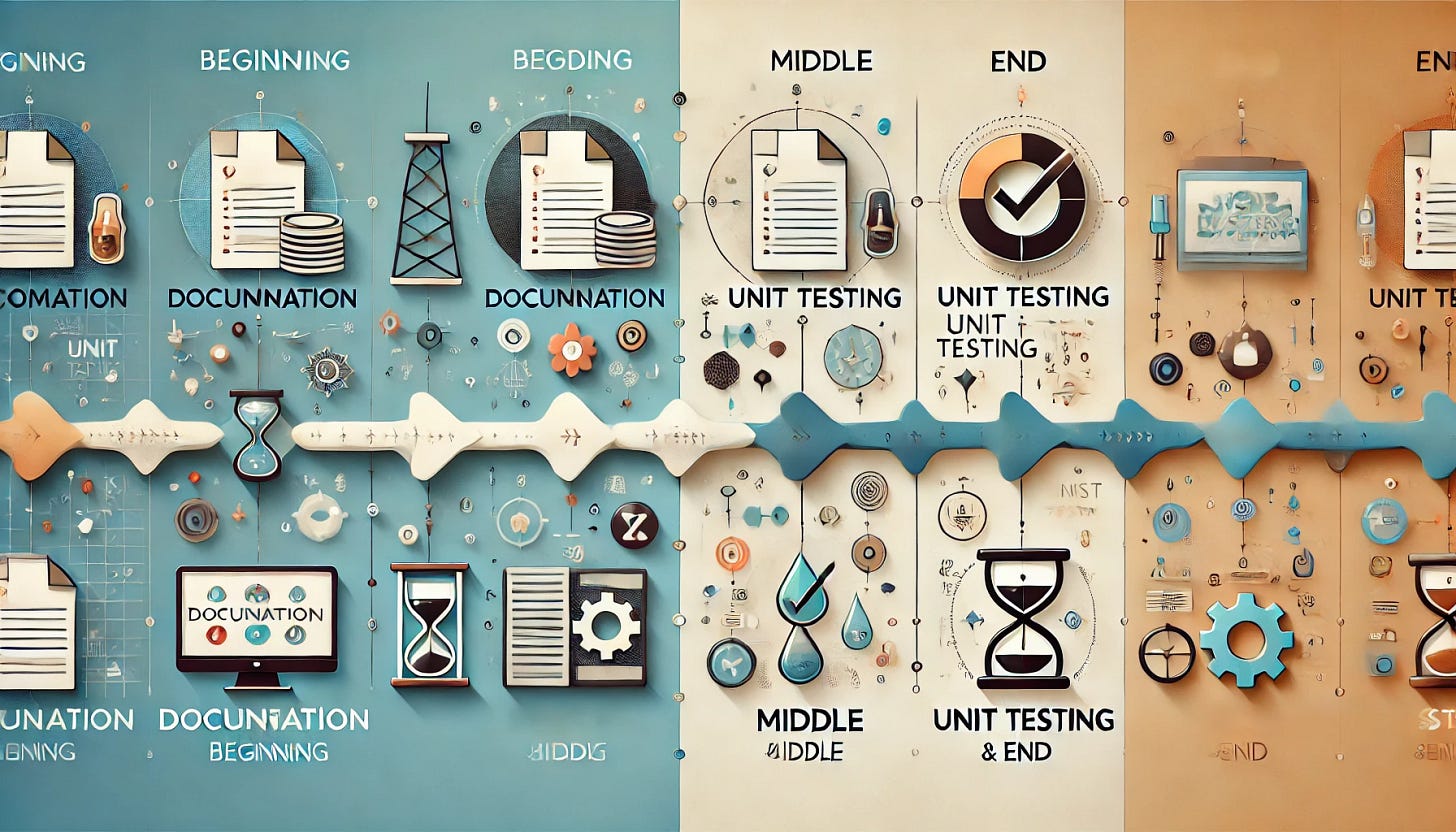When to Write Documentation and Unit Tests: Beginning, Middle, or End of the Project?
Striking the Right Balance for Quality and Productivity
Developers often grapple with the question of when to write documentation and unit tests during a project. Should it be at the beginning, middle, or end? Each approach has its merits and drawbacks, and the right choice often depends on the project’s complexity, goals, and team dynamics.
In this blog, we’ll explore the pros and cons of writing documentation and unit tests at different stages of a project and provide recommendations on achieving the perfect balance.
1. Writing Documentation and Unit Tests at the Beginning
Benefits
A. Clear Direction and Reduced Rework
Writing documentation early forces you to think through requirements, architecture, and potential edge cases.
Unit tests written first (test-driven development or TDD) ensure your implementation aligns with expected behavior.
B. Easier Onboarding for Team Members
Well-documented requirements and architecture make it easier for new developers to join mid-project.
C. Fewer Bugs Down the Line
Early unit tests catch edge cases and bugs before they propagate into larger parts of the codebase.
Drawbacks
Assumption Overload: Early documentation and tests might reflect assumptions that change as the project evolves.
Time Investment: Initial efforts may feel slower as you spend time documenting and testing before visible progress.
👋 Become 1% better at .NET Full Stack development every day.
👆 https://dotnet-fullstack-dev.blogspot.com/
♻ Restack it Vibe matches, help others to get it
Ideal Use Cases
Projects with well-defined requirements and scope.
Critical systems where failure is not an option (e.g., financial or healthcare software).
2. Writing Documentation and Unit Tests in the Middle
Benefits
A. More Accurate Documentation
By the middle of the project, the architecture and implementation details are clearer, leading to documentation that is more aligned with reality.
B. Realistic Unit Tests
Tests written after some development reflect actual implementation patterns, reducing the need to rewrite tests due to changing requirements.
C. Balanced Progress
You avoid early over-engineering and ensure the final stages aren’t overwhelmed by testing and documentation tasks.
Drawbacks
Risk of Technical Debt: Delaying tests or documentation until mid-project might mean some areas go untested or undocumented for longer periods.
Handoff Challenges: If new developers join early in the project, incomplete documentation can hinder onboarding.
Ideal Use Cases
Agile projects with evolving requirements.
Teams that prefer iterative development and continuous integration.
3. Writing Documentation and Unit Tests at the End
Benefits
A. Complete Picture of the Project
Writing documentation and tests at the end ensures that they reflect the final, stable implementation.
B. Faster Early Development
Developers can focus entirely on building features, reducing initial delays.
C. Avoid Redundancy
No wasted effort rewriting tests or documentation due to changes in requirements.
Drawbacks
Increased Risk of Bugs: Without early testing, bugs might remain undiscovered until late in the project.
Rushed Documentation and Testing: As deadlines approach, teams might cut corners on these tasks.
Higher Maintenance Costs: Testing and documenting after everything is built can be tedious and less effective.
Ideal Use Cases
Prototypes or MVPs where speed to market is critical.
Non-critical projects with flexible deadlines.
Which Approach is Best?
Recommendation: A Hybrid Approach
Rather than sticking rigidly to one stage, adopt a hybrid approach to balance the benefits and drawbacks:
1. At the Beginning
Write high-level documentation:
Requirements, architecture, and API contracts.
Focus on what the system should do, not how it’s implemented.
Write basic unit tests for critical components:
Validate core logic and edge cases early.
2. In the Middle
Expand documentation:
Add details as the architecture and implementation become clearer.
Write additional unit tests:
Cover new features and integration points as they’re developed.
3. At the End
Finalize and polish documentation:
Ensure all features are covered and discrepancies are resolved.
Add deployment instructions, troubleshooting guides, and user-facing docs.
Complete end-to-end and integration tests:
Validate the system as a whole.
Best Practices for Documentation and Unit Testing
Use Automation:
Tools like Swagger for API documentation and CI/CD pipelines for running unit tests save time.
Leverage Collaboration:
Involve both developers and non-developers in documentation to ensure clarity.
Continuous Testing:
Adopt a TDD approach for critical components but remain flexible for iterative development.
Iterative Documentation:
Treat documentation as a living artifact that evolves alongside the project.
Conclusion
The best time to write documentation and unit tests depends on the project’s nature and team workflow. Starting early ensures a solid foundation, doing it mid-project balances flexibility and structure, and finishing at the end can work for quick prototypes. However, a hybrid approach often provides the best results by combining the strengths of all three stages.
Remember: The goal is not just to have documentation and tests but to ensure they add value without becoming a bottleneck. Whether you start early, mid-way, or finish at the end, the key is to adapt your strategy to your project’s needs.
When do you prefer to write documentation and unit tests? Share your experiences and thoughts below!


